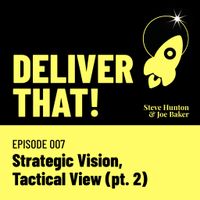Lovely though the views are, you're static on the mountain top. The journey doesn't happen here.
To get stuff done you have to come back down to ground level.
This is the world of your tactics.

In part 2 of the conversation we talk about execution — taking the strategy you created at the top of the hill and turning it into reality, with a thoroughgoing set of turn-by-turn actions.
This isn't a conversation about day-to-day delivery management — you already know plenty about all that. This is about executing your strategy.
We look at 4 dimensions:
1. Tactics: step-by-step instructions #
An action plan for your strategy is a clear set of step-by-step directions to follow. You'll definitely know the landmarks and way-points. But you should know a lot more than that, something close to a turn-by-turn guide so that you know what to do as you arrive at each of the challenges and opportunities on your voyage.
2. Tactics: equipped for the journey #
Your guide for the journey is essential, but it’s also important that you know you’ve got a good chance of success.
In other words, you have to be equipped for what you’re setting out to do — you have the right clothing and equipment for the climate and the right team with the right skills to tackle what you know you’re likely to face.
No point going on a trip wearing flip-flops and beach shorts and carrying an inflatable alligator if you’re aim is to travel across Antarctica to reach the pole.
3. Tactics: managing risks, known and unknown #
Your strategy should've identified the challenges and risks to your big venture. In your thorough planning, you'll have worked out how you're going to tackle particular obstacles, the bigger challenges you know are on your path ahead.
This is the definition of tactics, pretty much — how you're going to address specific things that are part of the larger plan, the distinct things you need to achieve or overcome in order to get where you're going.
And also recognising when the landscape has changed — you may need to pivot!
4. Tactics: Supporting the team, maintaining the tools #
Your tactics are the hard work you do at ground level, in the day to day.
And your tactics are the reason why you've drawn together this specific team and these particular tools — so that you can handle what you know is coming at you.
But nothing's indestructible. Your team needs rest and recovery, and they may need expanding through recruitment. Your tools needs to stay sharp, and they may need upgrading or augmenting.
Note: Strategy should always come first #
Tactics are a vector property. It's not just speed you want but velocity — travel in a particular direction. Tactics need to be directed toward a goal or outcome in order to have focus and purpose.
Tactics depend on strategy.
Beware of too much improvisation, too often #
Often the term 'tactics' is used as a synonym of 'improvise', but that's not really right. Yes, occasionally you will have to react, to be spontaneous.
But if you're doing that too often then it's a strong clue that you didn't spend long enough at high altitude, that you were impatient.
Pause.
And go back up the hill.
